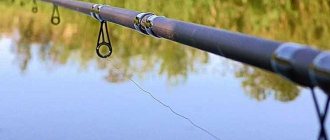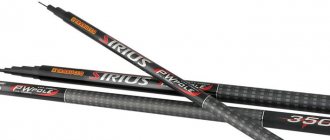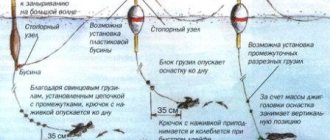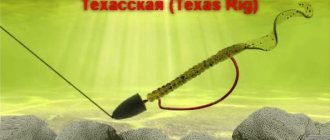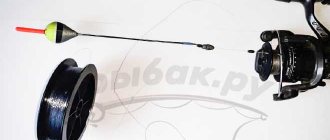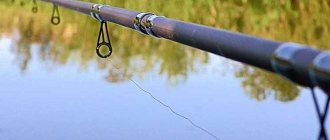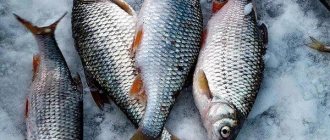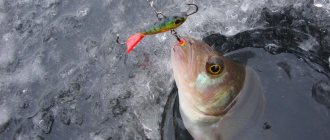How to choose the right fishing rod
A properly selected fishing rod will allow you to easily cast the equipment at the required distance and will help the angler when landing fish. When choosing a fishing rod, you should focus on the type of reservoir where you will be fishing, as well as the type of fish you intend to catch.
Flying float rod
With the right approach, fishing with a float rod from the shore can bring very impressive results. For coastal fishing, a classic fly rod with a blind rig is often used. Fly fishing rods differ from each other in several ways:
- length;
- building;
- manufacturing materials.
When fishing for bleak, short fly sticks with a length of 3 to 5 m are used, which have minimal weight and allow you to throw the equipment with one hand. To catch larger and more cautious fish, rods 6–10 m long are used, with the help of which it is possible to cast the equipment beyond the shore edge.
Fast action rods allow better control of the rig and are well suited for high-speed fishing for small fish. Slow-action rods are more often used when fishing for large fish, as they more effectively dampen the jerking of the trophy during fishing.
Modern fly fishing rods are made of carbon-based composite materials, which gives them maximum lightness and strength. When transporting, the tackle should be stored in a hard tube, since high-modulus carbon does not withstand shock loads well. The equipment is attached to the tip of the rod using a plastic connector.
Design of plug and Bolognese tackle
Plug tackle gives the angler the opportunity to fish with a very thin line and a light float. When fishing with a plug, the angler does not cast the equipment, but delivers it to the baited point by extending the rod, which allows the use of floats of minimal carrying capacity.
The length of plug fishing rods ranges from 10 to 16 m. The working part of the plug is called the “whale”. The length of the “whale” depends on the depth at the fishing site and can be changed by the fisherman during the fishing process. Inside the working part there is a rubber shock absorber that dampens the jerks of the fish when fishing. The shock absorber is passed through the hollow tip of the fishing rod, and at its end a voluminous knot is formed, to which the fishing line will subsequently be attached. The breaking load of the shock absorber is selected taking into account the diameter of the main monofilament.
Bolognese tackle is used for fishing with a float on the river and differs from fly fishing tackle in the presence of guide rings. The length of the “lapdog” can be from 5 to 8 m. The longer the rod, the easier it is to control the equipment during wiring. The “Bolonka” is equipped with a spinning reel of size 3000–3500, which is used for casting equipment and landing fish.
Match option feature
Match gear is more often used for float fishing in the fall, when the fish move far from the shore. Match fishing rods have a length from 3.5 to 6.5 m and are equipped with a spinning reel with a large additional number of bearings, which allows you to quickly reel in equipment from a long distance. Match “sticks” differ not only in length, but also in test. The test range is selected taking into account the load-carrying capacity of the float used and can range from 3 to 30 g.
Choosing the thickness and structure of the fishing line
For float fishing, monofilament monofilament threads are used. Monofilament lines have a number of advantages over other types of monofilament:
- good shock-absorbing properties, making it possible to fight large trophies using hooks made of thin wire;
- inconspicuousness in the water, which is necessary when fishing for cautious fish;
- good resistance to abrasive loads, which allows fishing on shell rocks and rocky soil;
- reasonable price, which is several times lower than for braided or fluorocarbon monofilaments.
Monofilaments with a diameter of 0.10–0.20 mm are used as the main fishing line. The thinner the main line, the faster the rig will reach the bottom.
Features of the leash
The leash is also knitted from “monofilament”; its diameter should be 0.02 mm less than the diameter of the main fishing line. A thin leash is less alarming to the fish and prevents the entire rig from breaking when the hook is caught.
The length of the leash when fishing in still water is 15–25 cm, and in currents it is 20–70 cm. If fishing takes place in a flowing body of water, the leash is attached to the main monofilament through a small swivel, which prevents it from twisting in the current. In still water, the “loop to loop” method is used to attach the leash.
How to properly equip a float fishing rod with two hooks?
You can’t be sure what the fish will bite on today, so fishermen practice attaching two hooks to the fishing rod at once. For example, worms are attached to the first hook, and bread to the second.
There is some valuable advice that says that there is no need to use large quantities of bait. A very small amount is required. Because on hot days it can quickly disappear and deteriorate, which negatively affects the condition of the inhabitants of reservoirs.
Which float to choose
Floats with a carrying capacity of 0.2 to 6 grams are installed on the fly rod, which have several attachment points and are distinguished by their oblong shape. The elongated shape facilitates the stable position of the alarm during wiring.
The Bolognese tackle is equipped with a spherical float, since a spherical signaling device is more stable in the current. The carrying capacity of such a float ranges from 2 to 15 g. The line is passed through the body of the alarm, which protects the body of the float from damage during vigorous hooking.
For fishing with a plug in still water, light floats with a carrying capacity of 0.2–1.5 g are suitable. If fishing takes place in the current, you will need to use flat alarms that have good hydrodynamics and operate stably even in a strong stream.
When fishing for fish using match gear, floats with a weight built into the body, 20–40 cm long and a load capacity of 2–30 grams, are used. Thanks to these characteristics, match alarms can be thrown 50–60 m.
Where to fish?
Fishing with a rod loves peace and quiet. Therefore, the best place for such an activity would be a small river, a secluded creek or the shore of a pond or lake. Numerous reservoirs also provide many convenient places, but we will not consider how to fish with a float in the middle of a huge free space. We'll make do with fishing from the shore, which is quite familiar to many.
Although it should be noted that there are no restrictions on the place of fishing with a fishing rod. You can fish anywhere. The advantage of this tackle is that it is universal and allows you to fish with a float both in currents and in still water, both on the banks of a modest forest stream under the canopy of trees, and on a huge reservoir.
But it is worth noting that most often with a float rod they are located on the shore of a quiet creek. After all, fish also settles down where it is calmer and more satisfying.
Types and shapes of sinkers
For this type of fishing, classic round lead sinkers, which have different weights and sizes, are better suited. Some anglers prefer elongated weights, believing that they are less likely to tangle the equipment. To load large bite alarms, whose carrying capacity is more than 3 grams, you can use an olive sinker, secured on the fishing line with small pellets, as the main load.
Loading the float when fishing in the current
For such gear, one lead sinker is not enough. In such conditions, the tackle often snags, so several sinkers will be required.
As a rule, fishermen give preference to 3 main types of float loading, depending on fishing conditions:
- When it is necessary to keep the bait at one point or carry out short-term retrieves. In this case, one load should be at the bottom of the river. Above it, at a distance of 3-5 cm, there should be two weights No. 3 and a weight that prevents the equipment from getting tangled. At a distance of 25 cm there is the main load, which has 90% of the total mass of the load.
- When postings are made with short-term stops. One load containing 10% of the total load should be at the bottom, and at a distance of 25-30 cm one pellet No. 5 is attached, and then, after 40-50 cm, a second pellet No. 5. After this, measuring 15-20 cm, the main load is attached, the value of which is 80% of the total load.
- When to catch bream. The float should have maximum stability, with reduced sensitivity. One pellet should be at the bottom. At a distance of 5 cm from this pellet, the remaining load is attached, which contains 90% of the total load. This loading technique does not allow for wiring, which every angler should remember.
Using a line spool
Float fishing with a Bolognese rod involves the use of a spinning reel, which allows you to cast the equipment to the desired distance. Reels for this type of fishing must have:
- a large additional number of bearings, which ensures quick reeling of the equipment and significantly increases the pace of fishing;
- finely tuned friction brake that prevents the line from breaking in the event of strong fish resistance;
- a spare spool, which makes it possible to quickly reconfigure the tackle;
- even winding of the fishing line, which contributes to the casting distance.
The reel should provide good balancing of the tackle and have a smooth ride. It would be good if the “spinless” vehicle was equipped with a rear friction brake.
Proper equipment of a float rod
For fishing to be successful, it is important to correctly assemble the float rod equipment. The assembly of the flywheel and plug version is as follows:
- at the end of a piece of monofilament fishing line, a loop is formed, which will subsequently be attached to the connector;
- the float is put on the main fishing line and attached to it using cambrics;
- a small loop is formed at the lower end of the monofilament for attaching the leash;
- a small sinker is installed close to the loop;
- a group of sinkers is attached 30 cm above, whose mass is about 30% of the total weight of the float;
- the main set of weights is installed half a meter higher;
- A leash with a hook is attached to the bottom loop using the “loop-to-loop” method.
The length of the rig should be 10–20 cm less than the length of the rod. An elastic band is put on the butt of the fishing rod, which serves to hook the hook.
The Bolognese version is equipped with one sinker. The load should be made in a sliding version, which will not allow the fish to feel its weight when biting. The equipment of the match tackle differs from the fly and Bolognese tackle in that the bulk of the weights are concentrated in the body of the bite alarm or moved close to it. This distribution of sinkers eliminates overlapping of the equipment when performing long casts.
Equipping a float rod with a float
A fishing rod without rings allows you to accommodate a piece of fishing line with a length equal to the length of the rod or 0.5 m longer than its length. With such a fishing line length, you can easily cast a fishing rod and pull it out of the water. In this case, the fish or hook will fall directly into the hand.
How to attach a float with a ring at the top to a fishing line.
- First you need to insert the fishing line into the ring, in an upward direction.
- A rubber cambric is put on the fishing line. Such a cambric can be purchased in a store. It is possible that it is included in the float kit, which is very rare.
- After this, the keel of the float is inserted into the rubber cambric. This can be seen in the figure.
How to attach a float without a ring to a fishing line.
There are times when you have to attach a float that does not have a fastening ring. In this case, you will have to take two cambrics of the appropriate diameter and put them on the keel and on the tip.
When selecting the size of the cambric, you need to remember that when the depth of immersion of the gear changes, the elastic band is triggered. To prevent this from happening and to prevent the elastic from breaking during fishing, it is better to avoid narrow elastic bands.
Some fishermen secure floats using stoppers. This method can be considered as an alternative option.
Quick float tackle! Crucian carp.Roach.Bream.Carp.Fishing.Fishing
How to fish with a float
After the tackle is assembled, you can proceed directly to fishing. Before you start fishing, you should decide on the fishing location, and also prepare the bait and bait mixture.
Searching for a promising location and determining the depth
For fishing with match and plug tackle, you need to choose places free from trees, where you can easily perform various manipulations with a long rod.
Since the casting range is limited by the length of the fishing rod, you need to look for a place on the reservoir where there is a hole or a channel edge near the shore. When fishing with a lapdog on a river, preference should be given to places with a clean bottom, which will prevent frequent snags of the hook on underwater obstacles. It’s good if there is a deep hole near the fishing point in which the fish settle.
Fishing with a float using a fly rod is possible almost anywhere in the reservoir, since this tackle allows you to throw the equipment to a promising point located far from the shore. To quickly and accurately measure depth, a small depth gauge weight weighing 5–10 g is attached to the hook.
Nozzles
Animal baits such as worms and maggots work better in early spring. When the water has warmed up above 12 degrees, you can switch to attachments of plant origin, which include:
- semolina dough;
- talker;
- Hercules;
- corn;
- pearl barley;
- bread crumb.
In autumn, fish bite better on bloodworms. Fish preferences can change throughout the day, so an angler should take at least 3 varieties of bait to a pond.
Flavors
In warm water, the bait and bait can be flavored with flavors with a pronounced sweet smell. If the water has cooled below 12 degrees, then spicy aromas are used to improve the bite:
- coriander;
- pepper;
- caraway;
- curry.
You should not treat all existing bait or bait with flavoring. With each cast of the bait, it is necessary to change the scent, gradually selecting the scent that arouses more interest in the fish.
Lure
Bait is an essential component of float fishing. For fishing, both purchased and homemade mixtures are used. The basis of a homemade bait mixture can be:
- breadcrumbs;
- wheat bran;
- corn flour;
- sunflower and hemp cake;
- various cereals.
To increase the fish-attracting effect, flavors and animal components are added to the bait. If fishing takes place in a reservoir with a strong current, then soil must be added to the bait.
Fishing technique
Arriving at a pond, the angler chooses a suitable place and mixes the bait mixture. While the bait is infusing, the fisherman sets up a chair, collects the gear and measures the depth in the fishing area. From the present bait, 5-6 lumps the size of an orange are formed and thrown into the fishing point. Throughout the fishing, the angler regularly supplements the fish by throwing balls the size of a walnut into the water.
After feeding, the fisherman baits the hook and throws the equipment into the baited area. Fish usually come up for bait within 10–30 minutes. After the bite, there is an immediate hooking followed by landing the fish.
Fishing technique with a float rod
general information
You can fish with such a float rod at depths of no more than 2-3 meters. The greater the fishing depth, the shorter the distance you can throw the tackle.
Many fish, such as carp, crucian carp, perch, silver bream, and bream, lead a bottom-dwelling lifestyle, and also, like the perch, bleak, and rudd, they are closer to the surface. It is very important to know what kind of fish you are hunting for in order to set the depth correctly. The fishing depth is adjusted by moving the float along the main line. The further the float is from the hook, the greater the fishing depth. If there is 1 meter from the hook to the float, then fishing is carried out at a depth of 1 meter from the surface of the water.
Searching for a promising location and determining the depth
Not all fishermen have such a device as an echo sounder, so determining the depth of the reservoir at the fishing site is carried out experimentally. The relief of a reservoir can be determined by analyzing the surface state of the water. This is not very difficult to determine on a river if there is a current. If fishing is carried out in calm water, then the depth in this particular place can be found out using a fishing rod.
To do this, knowing the approximate depth, set the float on the tackle and throw it into the water. If the float stands perfectly, then depth can be added. The fishing depth is set until the float takes a horizontal position, which will indicate the true depth of the reservoir at the fishing site. Then it is reduced by the size of the leash. This will mean that the hook with bait will be directly at the bottom and you can begin to catch fish that lead a bottom-dwelling lifestyle.
Nozzles
Naturally, the fish will not bite on an empty hook and you need to put some kind of bait on the hook. These can be baits of animal origin or baits of plant origin.
The following can be used as animal baits:
- Bloodworm.
- Maggot.
- Dung or earthworm.
For plant attachments you can use:
- The dough is different.
- Boiled corn or peas.
- Pearl barley or wheat porridge.
If the bite is not active, then you can bait sandwiches, that is, combine baits of animal and plant origin.
Lure
Fishing will be more effective if you feed the fish and try to keep it in the fishing spot for as long as possible. For this purpose, various bait mixtures are used. You can buy them in the store or prepare them yourself. Then, small balls are molded from the bait and thrown into the pond exactly in the place where the float will be located.
The following components are used to prepare bait mixtures:
- Pearl barley.
- Millet cereal.
- Cake.
- Dill.
- Bran.
- Breadcrumbs.
- Other components.
If you have to fish in the current, then clay or earth should be added to the bait. Such balls will reach the bottom of the reservoir without any problems. In order for bait to be effective, the same components that are used for all fishing should be added to it: if fishing is done with a worm, then chopped worms, etc. can be added to the bait. This technique makes the bait more natural and does not alarm the fish as much.
The purpose of bait is to attract fish, not to feed them. If fishing is carried out on a current, then the result from bait should be expected after 15-20 minutes, and if on calm water, then the full effect may appear much later. For a more pronounced effect, aromatic additives can be added to bait mixtures.
You can buy, but expensively, bait from the following companies:
- Sensas
- Traper
- Vde
- Pelican
- Dunaev.
These baits can be recommended for use, as they have proven their effectiveness in practice.
The following can be used as flavorings:
- Hemp.
- Anise.
- Other components for other fishing conditions.
